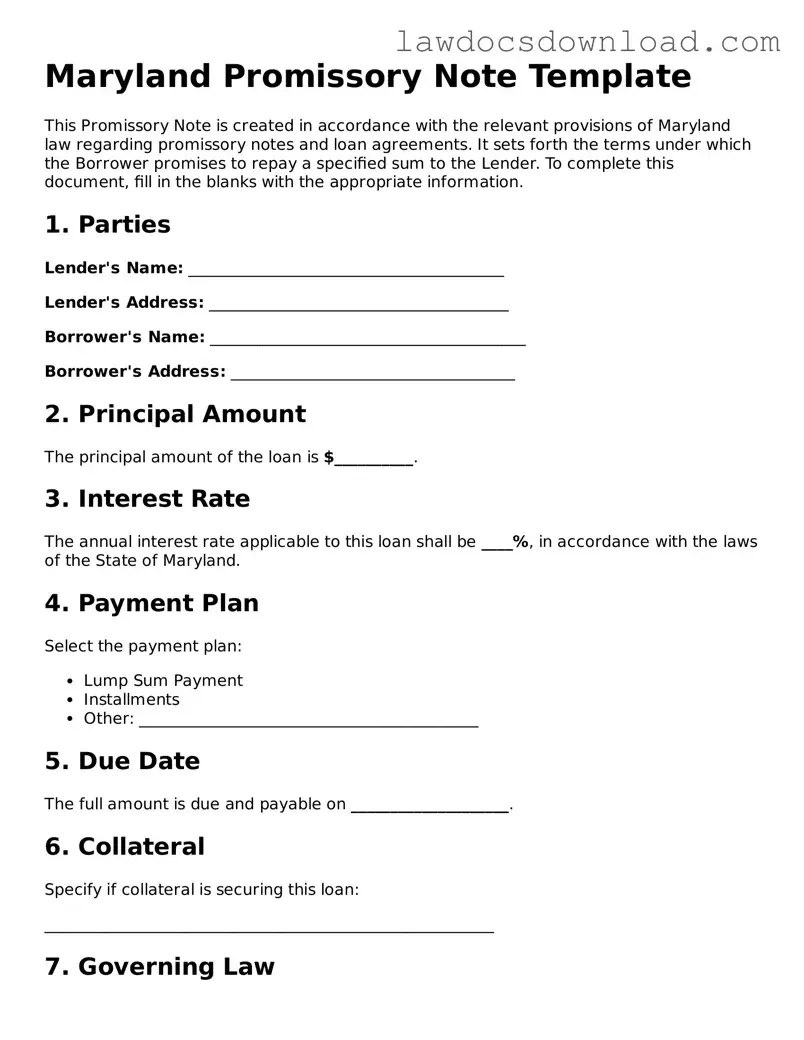The Loan Agreement shares similarities with the Maryland Promissory Note form, primarily due to its function of documenting the terms and conditions of a loan between two parties. In a loan agreement, the amount borrowed, interest rate, repayment schedule, and consequences of default are clearly outlined, much like they are in a promissory note. The main difference often lies in the level of detail and formalities involved, with loan agreements typically being more comprehensive and used for larger, more complex transactions.
A Mortgage Agreement is another document akin to the Maryland Promissory Note, as it specifically secures a loan on real property. Like a promissory note, a mortgage agreement outlines the borrower's obligation to repay the borrowed amount under agreed terms. However, it goes further by binding the loan to the physical property, allowing the lender to foreclose on the property if the borrower defaults, showcasing a key distinction tied to security and enforcement mechanisms.
The Personal Guarantee is related to the concept of a promissory note but from a third-party perspective. It involves an individual or entity (the guarantor) agreeing to repay a loan if the original borrower fails to do so, providing an additional layer of security to the lender. While a promissory note binds the borrower to the repayment terms, a personal guarantee extends the financial responsibility beyond the borrower, thus highlighting its role in risk mitigation for the lender.
An IOU (I Owe You) document is a simpler cousin of the Maryland Promissory Note, serving as a casual and informal acknowledgement of debt between two parties. While an IOU notes the basics like the amount owed and the parties involved, it lacks the legal robustness and detailed terms (such as repayment plan, interest, and collateral) typically found in a promissory note. This makes an IOU more suitable for minor loans between individuals who have a trust-based relationship.
Credit Agreements bear resemblance to promissory notes by detailing the terms under which credit is extended from a lender to a borrower. These agreements encompass a broad range of credit types, from personal loans to revolving credit lines, and define terms of interest rates, repayment schedules, and default consequences. Unlike promissory notes, which are usually more straightforward and involve a single lump-sum repayment or simple installments, credit agreements can offer more flexibility in borrowing and repayment terms.
The Deed of Trust is another related document, placing a third party in control of a borrower's property until a loan is fully repaid, similar to how a mortgage functions. This document accompanies a promissory note in transactions where real property is used as collateral. Despite its similarities, the deed of trust involves three parties (borrower, lender, and trustee), unlike the direct lender-borrower relationship in a promissory note, illustrating the inclusion of an intermediary in the lending and repayment process.
Student Loan Agreements are specialized versions of promissory notes, designed exclusively for borrowing funds to cover educational expenses. They outline the terms of repayment, interest rates, deferment policies, and forgiveness options — elements also present in standard promissory notes. However, what sets these agreements apart are the specific conditions and protections afforded to borrowers, reflecting the unique purpose and public policy considerations of educational financing.
Finally, a Line of Credit Agreement shares attributes with promissory notes, offering a flexible borrowing mechanism where the borrower has access to a specified amount of funds over a set period. Borrowers can draw from, repay, and redraw funds within the credit limit, making it distinctively adaptable compared to the static amount and repayment schedule of a promissory note. Both documents serve to formalize the terms under which money is borrowed, but the line of credit provides ongoing access to funds, unlike the one-time transaction nature of most promissory notes.
